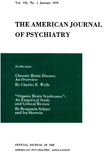Clonazepam and phenobarbital in tardive dyskinesia
Abstract
Benzodiazepines have several advantages over other antidyskinetic drugs in treating tardive dyskinesia. The authors conducted a controlled study of clonazepam versus the active placebo of phenobarbital in 21 psychiatric patients with tardive dyskinesia. Both drugs significantly reduced dyskinetic movements: clonazepam had a stronger effect on orofacial dyskinesia, and phenobarbital was more effective for limbs and axial movements. Clonazepam was also more effective for drug-free patients and those receiving low doses of neuroleptics than for all patients given phenobarbital and for clonazepam patients taking high doses of neuroleptics. The authors suggest that future treatment studies focus on the effects of antidyskinetic drugs on distinct body regions.
Access content
To read the fulltext, please use one of the options below to sign in or purchase access.- Personal login
- Institutional Login
- Sign in via OpenAthens
- Register for access
-
Please login/register if you wish to pair your device and check access availability.
Not a subscriber?
PsychiatryOnline subscription options offer access to the DSM-5 library, books, journals, CME, and patient resources. This all-in-one virtual library provides psychiatrists and mental health professionals with key resources for diagnosis, treatment, research, and professional development.
Need more help? PsychiatryOnline Customer Service may be reached by emailing [email protected] or by calling 800-368-5777 (in the U.S.) or 703-907-7322 (outside the U.S.).



